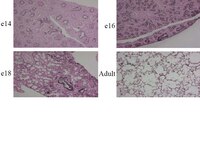Vesicle transport in oligodendrocytes: probable role of Rab40c protein.
Rodriguez-Gabin, A G, et al.
J. Neurosci. Res., 76: 758-70 (2004)
2004
Afficher le résumé
Intracellular membrane trafficking plays an essential role in the structural and functional organization of oligodendrocytes, which synthesize a large amount of membrane to form myelin. Rab proteins are key components in intracellular vesicular transport. We cloned a novel Rab protein from an oligodendrocyte cDNA library, designating it Rab40c because of its homology with Rab40a and Rab40b. The DNA sequence of Rab40c shows an 843-base pair open reading frame. The deduced amino acid sequence is a protein with 281 amino acids, with a molecular weight of 31,466 Da and an isoelectric point of 9.83. Rab40c presents a number of distinct structural features including a carboxyl terminal extension and amino acid substitutions in the consensus sequence of the GTP-binding motifs. The carboxyl terminal region contains motifs that permit isoprenylation and palmitoylation. Binding studies indicate that Rab40c binds guanosine 5'-0-(3-thiotriphosphate) (GTP gamma S) with a K(d) of 21 microM and has a higher affinity for guanosine triphosphate (GTP) than for guanosine diphosphate (GDP). Rab40c is localized in the perinuclear recycling compartment, suggesting its involvement in endocytic events such as receptor recycling. The importance of this recycling in myelin formation is suggested by the increase in both Rab40c mRNA and Rab40c protein as oligodendrocytes differentiate. | 15160388
 |



















